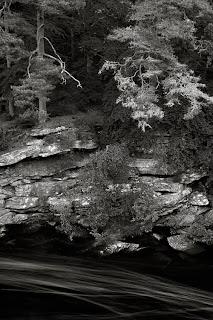
"The universe as we know it
is a joint product of the
observer and the observed.”
Philosopher / Mystic
(1881 - 1955)
While looking over some old photos (going back to trips to Scotland in 2009 and Greece in 2008), I ran across an interesting set of pictures taken by my wife that I turned into what I call PPDs, or "Photographing the Photographer" Diptychs. My wife, an avid videographer and occasional still photographer, took a series of images showing yours truly in the act of "doing" photography.
Some of her photos contain "me" only in the sense that I am somewhere in the picture, but the shot itself is focused on something else; a landscape, our rental car, a hotel, the front of a restaurant, whatever. But many of them are (as my wife confessed) deliberately focused on my (not always elegant) photo machinations: my scurrying to and fro like a frenzied zombie, climbing, prowling, bending, scrunching up like a pretzel, maneuvering my body and tripod for decent angles. A few actually catch me in the "act" of going click.
For many of these I was able to find and match the "shot" I was capturing (or a shot taken at nearly the same place and time) with the shot my wife has of me doing so. I made a few diptychs to show my wife and friends, who all enjoyed them, commenting that the diptychs reveal something not normally seen, or appreciated.
The diptychs show two different - but obviously correlated - experiences by two different people of ostensibly the same "experience" (almost the same). While my wife and I were obviously both at the same place and time, we were looking at the world from our own (not quite identical) local reference frames and slightly different perspectives: she, as an empathic observer of "life (in this case, her husband's) in environment," and I, as landscape photographer immersed in Scotland's innate physical beauty. To my eyes, our respective images of a given time and place, combined in diptych form, achieve an interesting transcendent synergy. While neither image, if considered alone, shows anything more than it does by itself, when reflected upon simultaneously with its partner provides a tangibly more meaningful, deeper glimpse of our shared experience.
I have posted a small portfolio of ten such "Photographing the Photographer" Diptychs (8 from Scotland, 2 from Greece); if nothing else, it gave me an opportunity to revisit some of the many spectacular sights and visual delights my wife and I have been privileged to see. It also gives an opportunity to those of you (you know who you are ;-) who have, from time to time, seen a bespectacled photographer bent over a tripod somewhere, seemingly trained at nothing in particular, and been puzzled about just what this bespectacled photographer is looking at? My wife has kindly provided an answer.

























